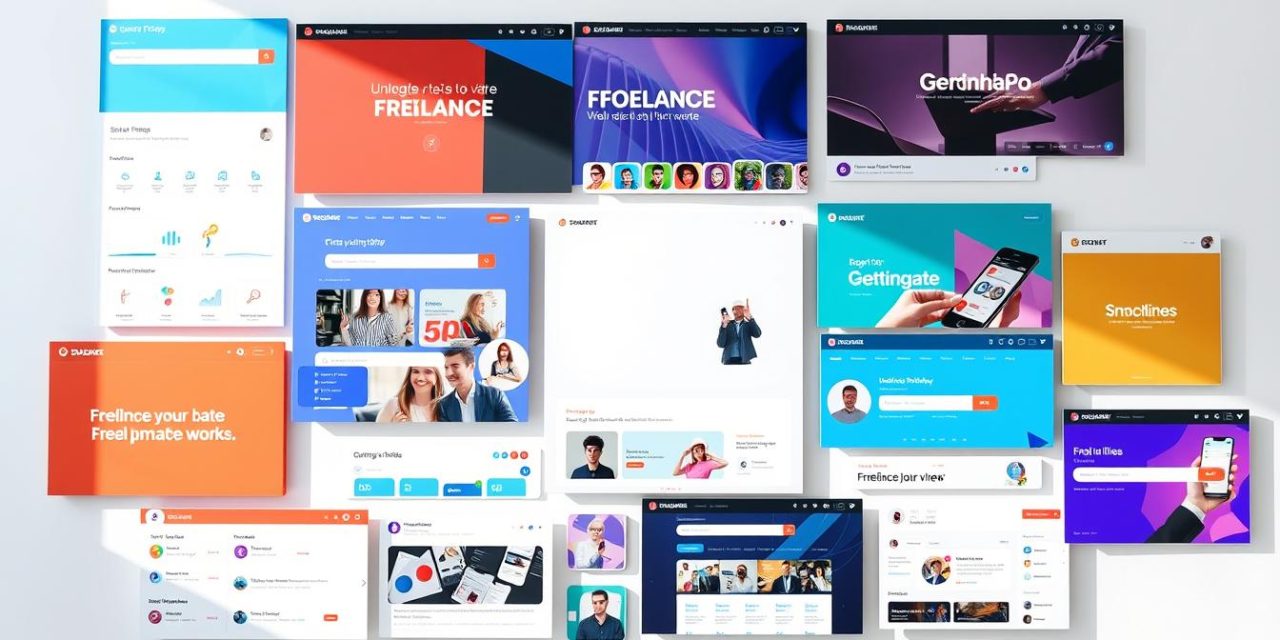In France today, millions work independently and many turn to online platforms to connect with clients and companies. These centralized sites make it simple to find work, compare offers, and present a strong profile with a clear portfolio.
From Malt to Upwork or Fiverr, platforms vary: some add payments, invoices, and dispute support, while a job board may only list projects. French names like HelloWork, Codeur.com and Freelance Informatique sit alongside global sites, offering roles from web and IT to marketing, design, and writing.
Visibility depends on ratings, samples, and positioning. Whether you want side gigs or a full-time pipeline, the right board and strategy can speed client matches or demand more nurturing. In the next sections, we compare strengths, categories, fees, and workflows to help you pick the best place to grow your career.
Table of Contents
Key Takeaways
- Online boards centralize demand and help you find work faster.
- Platforms often include payment and dispute tools; sites may not.
- France has strong local players (Malt, Freelance Informatique) and global options.
- Your profile, portfolio, and ratings shape client trust and visibility.
- Choose a board by services offered, competition, and project type.
- Next sections will compare platforms by strengths and fees for France and beyond.
Why freelance job boards matter right now
Online listing hubs turn scattered demand into a searchable market for talent and teams. In France, 3.3 million people worked independently in 2023, and platforms now gather thousands of offers so professionals can quickly find work.
Consolidation speeds matching: boards condense demand so clients compare portfolios and profiles side‑by‑side. That shortens hiring cycles and helps companies source vetted talent faster.
During hiring peaks or economic uncertainty, these platforms surface fresh jobs and filter opportunities by skill, duration, and location. Alerts and search tools reduce endless outreach and keep a steady pipeline.
- Career momentum: consolidated listings let you test niches, raise rates, and build a portfolio that attracts inbound requests.
- Time horizons: some sites feed quick gigs; others surface multi‑month contracts—pick the place that fits your season.
- Resilience: access to daily new listings softens slow months and shortens the time to find work.
Trust and visibility matter: verified platforms with payment tools and reviews cut risk for both clients and talent. A strong profile compounds over time, turning one‑off wins into steady opportunities.
Next, we’ll unpack how to choose the right site to match your goals, timeline, and appetite for competition. For a broader list of top platforms, see this top platforms roundup.
How to choose the right job board for your skills and goals
Picking the right platform starts with matching its audience to your language and sector. If your skills and expertise fit the French or EU market, local sites often surface better-matched projects. For global reach, larger platforms list more work but bring tougher competition.
Compare filters and project types: check on-site vs. remote options, sector tags (IT, web, design, writing), and typical project duration. That helps you pick sites that suit short gigs or longer contracts.
Fees, protection, and client quality
Fee models vary: subscription, per-proposal credits, or revenue share. Look closely at commission and how payments are protected—escrow and milestone systems reduce payout risk.
« Upwork verifies both clients and freelancers; applying requires paid ‘connects’ after an initial allowance. »
| Feature | Example | Benefit |
|---|---|---|
| Verification | Upwork | Fewer low-quality clients |
| Freemium replies | Codeur.com | Low client cost; freelancer subscription |
| Low fees + management | PeoplePerHour | Project Streams for invoicing and delivery |
- Prefer sites with tests or curated listings for steady client quality.
- Choose workflow features—messaging, file management, dispute tools—that save time.
- Match your growth plan: use a forgiving site when testing, a specialist board for higher rates.
For a wider list of top platforms, see this best sites roundup.
Best freelance job boards for France and Europe
Choosing where you list your services shapes the types of clients and projects you attract. Below are the main sites used by French talent, with practical notes to help you match platform economics and mission style.

Malt
Malt serves France and the EU with strong media visibility and enterprise programs. It handles payments, invoicing, legal compliance, and professional liability insurance.
Pros: great for companies that need on-platform compliance and for professionals who want secure payments and broader visibility.
Freelance Informatique
This site lists 150,000+ IT profiles and targets grands comptes in banking and insurance. Missions are often long, technical, and on-site.
Good when: you seek stable, high-expertise contracts with larger companies rather than short remote gigs.
Codeur.com
Founded in 2006, Codeur.com runs an RFP model where clients post briefs and professionals bid. Clients use it free; responders need a subscription to reply.
Best for: web, design, and marketing projects—especially for those building reviews and remote work experience.
HelloWork
HelloWork hosts 700,000+ listings and favors traditional roles with salary transparency and application tracking. It lists some freelance work but is more selective for short missions.
Redacteur.com & Graphiste.com
These niche sites focus on writing and design briefs, with project managers and CopyScape-verified checks for uniqueness.
Trade-off: accessible rates for newcomers and steady briefs to grow a portfolio, though top-end rates may be lower than specialized high-end sites.
For more strategic tips on growing income and clients in France, see becoming rich as a freelancer in.
Global leaders where freelancers find steady work
Top global sites combine scale, safety tools, and diverse opportunities that suit many skills.
Upwork
Upwork is a massive marketplace with verified clients and freelancers. It supports messaging and video calls to keep communication clear.
Applying uses free credits initially, then paid connects. Be selective: target listings where your profile stands out and aim for longer projects to offset fees.
Fiverr
Fiverr uses a storefront model across 500+ categories. Signup is free, payments are protected, and 24/7 support helps smooth deliveries.
Think productized services: clear packages, strong visuals, and steady reviews drive visibility. Expect competition and commission that affect margins.
Freelancer.com
Freelancer.com claims large reach and 1,800 skills. It adds contests and learning modules so professionals can showcase and improve abilities on platform.
Flexible hourly and fixed pricing suit varied work styles. The site is mainly English-focused, so French users should target listings that match their language and rates.
- Tip: refine your profile, use saved searches, and pitch outcomes not just tasks.
- Strategy: start with small wins to build social proof, then pursue longer projects that stabilize income.
Specialist and niche freelance job boards to target your expertise
Niche sites connect specific talents with buyers who know what to pay for proven results. Use specialist platforms to reach better-fitting clients and faster, higher-value projects.
Toptal
Elite vetting: Toptal accepts about 3% of applicants after personality reviews, skills tests, live screenings, and test projects.
Why it matters: companies like Microsoft and Salesforce hire here, so rates and trust are higher—but the screening takes time.
99designs
This design-only site hosts 90+ categories, from logos to brand systems.
Note: expect extra fees when starting engagements with new clients.
PeoplePerHour
AI matching pairs profiles to relevant listings. Low fees and Project Streams simplify communication, delivery, and invoicing.
We Work Remotely
This remote-first site draws about 250,000 monthly visitors and posts 900+ new positions. Listings favor companies with remote cultures.
Behance & Dribbble
Both are portfolio-first communities where your profile and work drive discovery. Behance links to Adobe’s ecosystem; Dribbble mixes portfolio exposure with community feedback.
FlexJobs
Subscription-based and hand-screened, FlexJobs reduces scam risk and adds coaching and webinars to help paid users find quality opportunities.
- Pairing tip: combine a portfolio site (Behance/Dribbble) with a specialist platform (99designs or Toptal) to improve conversion on graphic design briefs.
- Strategy: track which site and listing type yield repeat clients, then focus your profile on that niche.
| Platform | Focus | Key Benefit |
|---|---|---|
| Toptal | Premium technical & design talent | High-trust, high-rate projects; rigorous screening |
| 99designs | Design categories (90+) | Wide design briefs; good for creatives building portfolios |
| PeoplePerHour | Mixed skills with AI match | Low fees and Project Streams for smoother workflow |
| We Work Remotely | Remote tech & creative roles | High volume of remote listings and steady visibility |
| Behance / Dribbble | Portfolio-first communities | Discovery via profile and showcased projects |
| FlexJobs | Hand-screened remote & flexible listings | Curated, lower-scam risk plus career resources |
Fees, commissions, and payments: what freelancers need to know
Understanding platform fees helps you keep more of each contract and pick the best places to spend your time.

Platforms use several pricing models that change your net take per job. Common options include subscriptions (Codeur.com), per-bid credits (Upwork connects), and revenue shares. Some direct, no-commission boards lower cost but offer less mediation.
Commission structures, subscriptions, and “no-fee” options
Compare commission versus subscription math before committing. Low-fee sites like PeoplePerHour boost take-home and include Project Streams for communication and invoicing. Upwork charges connects after an initial allowance and applies tiered take rates that fall for long-term work.
Escrow, invoicing, and compliance: staying secure and paid on time
Payment protection matters. Use platforms with escrow, milestone releases, and built-in invoice tools to cut risk and speed payouts.
For work in France, prefer sites that generate compliant invoices and supply basic legal docs. This simplifies tax reporting and social insurance steps for many freelancers.
- Simple plan: join two or three platforms with different fee models and review quarterly.
- Management tip: keep communication, files, and delivery inside platform workrooms to avoid disputes.
- Time budget: track hours spent applying and revising—fees are only part of project ROI.
| Model | When to use | Example |
|---|---|---|
| Subscription | High-volume replies | Codeur.com |
| Per-proposal | Selective pitches | Upwork (connects) |
| No-commission | Direct leads, lower fees | Freelance-Engineering |
« A clear fee plan reduces surprises and helps you compare platforms by net income. »
Marketing yourself on job boards: stand out and win better clients
Your profile is the first sale: craft a headline and three quick case studies that show measurable outcomes. Clients glance at results, so lead with impact—conversion, time saved, or revenue lifted.
Optimize your profile, portfolio, and social proof
Use a clean portfolio entry for each major project. Add short metrics and a one-line outcome.
Collect reviews quickly after delivery and respond to feedback. Platforms like Upwork and Fiverr reward fast replies and strong ratings with more visibility.
Targeted proposals and rate positioning
Lead proposals with client outcomes, reference similar projects, and anchor your rate to value. Templates speed replies while keeping personalization.
Skills tests, certifications, and niche expertise
Add relevant tests and certifications to pass filters. Toptal-level rigor is a useful goal for premium listings.
Time management and pipeline diversification
Set daily application caps and track which sites yield the best clients per hour. Mix one global platform, one specialist site, and a France/EU option to balance volume and fit.
- Quick wins: three case studies, two testimonials, and a clear availability note for side work.
- Use platform tools: PeoplePerHour Project Streams or FlexJobs coaching to speed proposals and improve outcomes.
| Action | What to do | Benefit |
|---|---|---|
| Profile headline | State niche + outcome | Higher click-throughs |
| Portfolio entries | 3 case studies with metrics | Faster client trust |
| Skills & tests | Add certificates and platform tests | Unlock premium invites |
« Small, measurable marketing moves compound into a stronger career and better projects. »
Freelance job boards by use case
Match your skills to a specific place to find faster, higher-quality opportunities. Below are practical recommendations by sector so you spend less time applying and more time winning work that fits your rate and rhythm.
IT and engineering
Freelance Informatique is ideal for France-based enterprise roles—expect longer, on-site engagements with grands comptes.
Freelancer Map and Elevate suit IT professionals who want direct, no-fee applications and CV-driven matching.
Writing and content
Start with Redacteur.com to build samples and client reviews. Move to Contena for curated, higher-paying listings and coaching.
ServiceScape is a good add when you offer editing or translation alongside writing services.
Design and creative
99designs handles brand, UI, and creative contests across many categories.
Use Behance and Dribbble as portfolio hubs to attract inbound work. The Dots adds community and collaboration opportunities.
Remote-first and flexible
FlexJobs hand-screens listings for quality. We Work Remotely posts high-volume remote roles, while Dynamite Jobs curates remote-first companies.
Latin America and global alt-markets
Workana connects Spanish and Portuguese markets. Guru offers flexible payment options and workrooms. Contra is commission-free with built-in portfolios and proposals.
Quick strategy: combine one specialist board and one broad platform to balance lead flow and higher-value listings. For side work, pick sites with direct apply or no commission so you can accept small projects fast.
| Use case | Recommended sites | Primary benefit |
|---|---|---|
| IT & Engineering | Freelance Informatique, Freelancer Map, Elevate | Enterprise roles, direct applies, auto-matching |
| Writing & Content | Redacteur.com, Contena, ServiceScape | Sample building, curated listings, editing services |
| Design & Creative | 99designs, Behance, Dribbble, The Dots | Brand briefs, portfolio discovery, community |
| Remote & Alt-markets | FlexJobs, We Work Remotely, Dynamite Jobs, Workana, Guru, Contra | Vetted remote roles, regional reach, commission-free options |
Conclusion
Choose fit over frenzy: match category, workflow, and fees so your freelancing time converts to better work and repeat clients.
For France and Europe, pair Malt or Freelance Informatique with a global platform like Upwork to balance local compliance and wider opportunities. Add one niche option — 99designs, Redacteur.com, or Toptal — to reach companies that pay for depth.
Keep fees, escrow, and protections top of mind to reduce admin and get paid on time. Optimize your profile, collect reviews, and track performance by board and board type.
Quick nudge: shortlist three sites today, refresh your profile, and apply to five targeted listings to start the next chapter in your career.
FAQ
What are the top platforms for finding freelance work in France and Europe?
In France and across Europe, look at Malt for broad enterprise reach, Freelance Informatique for IT and engineering contracts, Codeur.com for RFP-style web and marketing projects, HelloWork for more traditional roles that sometimes include mission-based work, and specialist marketplaces like Redacteur.com and Graphiste.com for content and design briefs.
How do global marketplaces differ from niche platforms?
Global platforms such as Upwork, Fiverr, and Freelancer.com offer vast reach and many project types, often using proposal systems and profile-driven sales. Niche sites like Toptal, 99designs, or PeoplePerHour focus on vetted talent, design-specific briefs, or AI matching — which can yield higher-quality clients and better rates for targeted skills.
What should I check about fees, commissions, and payment protection?
Compare commission structures (percentage per contract vs. subscription), transaction fees, and whether the platform offers escrow or invoicing tools. Platforms with escrow and verified payments reduce risk and help ensure you get paid on time. Also verify tax and compliance support for your country.
How can I choose the right site based on my skills and goals?
Match platform market reach to your language and target clients, weigh on-site vs. remote filters, and consider competition level. If you want premium projects, choose vetted networks; for steady volume, pick large marketplaces. Prioritize sites with category filters that match your expertise and clear client verification.
How do I make my profile and portfolio stand out?
Use a clear headline, showcase recent case studies with measurable results, and highlight niche certifications or skills. Add social proof like client testimonials and include concise samples that demonstrate process and outcome. For designers, keep Behance or Dribbble portfolios up to date.
Are skills tests, certifications, or badges worth pursuing?
Yes. Tests and recognized certifications can reduce friction with clients and improve visibility in search results. Use platform assessments selectively — prioritize those relevant to your services and the clients you target to avoid diluting your profile.
What client signals indicate good-quality opportunities?
Look for verified payment methods, repeat-hire history, detailed briefs, and clear budgets. Clients who communicate promptly, provide scope and milestones, and have positive reviews from other professionals usually lead to smoother engagements and timely payments.
How should I price my services and position rates on different sites?
Research typical rates for your niche and region, account for platform fees, and set tiered offerings: basic, standard, and premium. For proposals, explain value and outcomes rather than hourly time. Test pricing and adjust based on response and client quality.
What are best practices for submitting proposals and winning projects?
Personalize each proposal to the brief, start with a short résumé of relevant experience, outline a clear plan and timeline, and include a competitive but realistic rate. Attach tailored samples and end with a call to action to discuss next steps or a short discovery call.
How can I diversify my pipeline to avoid relying on a single platform?
Combine a presence on one or two large marketplaces with niche sites tailored to your skills, maintain a portfolio site, and use LinkedIn, direct outreach, and content marketing to attract clients. A balanced mix reduces dependency and improves long-term stability.
What payment methods and invoicing features should I expect?
Look for platforms offering escrow, integrated invoicing, milestone payments, and clear withdrawal options (bank transfer, PayPal, or Stripe). Ensure the platform supports compliant invoices and that you understand withdrawal fees and processing times.
Are contests and fixed-price listings worth it for creatives?
Contests can boost exposure for designers but often pay less relative to time invested. Use contests selectively to build a portfolio or try new styles, while prioritizing direct briefs and client relationships for sustainable income and fair compensation.
Which sites are best for writers and editors?
For writers, consider Redacteur.com and Contena for curated briefs, ServiceScape for editing and niche projects, and global marketplaces for volume. Focus on sites that match your language skills and content specialties to command better rates.
How do remote-first platforms differ from regional marketplaces?
Remote-first platforms like We Work Remotely and FlexJobs emphasize telecommute roles and flexible schedules, often curated and hand-screened. Regional marketplaces target local clients, may operate in the local language, and can simplify tax or compliance for local engagements.





